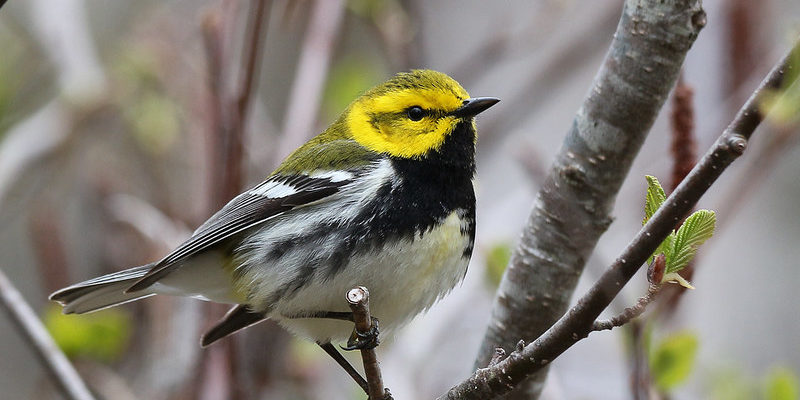Bird of The Week: Black-throated Green Warbler
SCIENTIFIC NAME: Setophaga virens
POPULATION: 8.7 million
TREND: Increasing
HABITAT: Nests in coniferous and mixed forests; winters in high-elevation forests
The pretty little Black-throated Green Warbler is aptly named, with a green crown, back, and rump; black throat, upper breast, and wings; and lemon-yellow face. The amount of black on its throat and breast varies according to the bird’s age and sex, with adult males the most boldly marked. This is one of the more familiar migratory warblers found in the eastern United States, and is fairly easy to spot on its breeding grounds, as males sing persistently. One was recorded belting out 466 songs in an hour!
The Black-throated Green closely resembles several other warbler species, including the Townsend’s Warbler, which nests in the Pacific Northwest. Some scientists actually consider these two species to be part of a larger group of closely related warblers. This classification, however, is not universally accepted.
Superspecies
Some scientists consider the Black-throated Green Warbler and near relatives, including the Golden-cheeked, Hermit, and Townsend’s Warblers, and possibly the Black-throated Gray Warbler as well, to be part of a “superspecies” — a group of related species that evolved in isolation from one another and remain separated by geographical barriers.
The concept of a superspecies illustrates evolution in action, with geographical barriers leading to the eventual formation of distinct species. In the case of the Black-throated Green Warbler, this speciation probably occurred after prehistoric glacial movements separated groups of a common ancestral bird.
However, some taxonomists consider this concept to be rather nebulous, since there is no obvious dividing line between members of a superspecies and distinct subspecies. To complicate matters, while perhaps validating the concept, members of this warbler superspecies regularly hybridize in the few places where their ranges overlap.
Bird of Boreal Woods
The Black-throated Green Warbler breeds mainly in boreal areas of eastern and central North America, including the Great Lakes region, New England, and the Appalachians, south to northern Alabama. A separate population breeds in swamplands in the Coastal Plain of Virginia and the Carolinas.
Like most of its family, this warbler is a nocturnal migrant. While foraging during stopovers in fall and spring, it sometimes joins mixed-species flocks that include the Black-capped Chickadee, Tufted Titmouse, Golden-crowned Kinglet, and other warbler species. The Black-throated Green Warbler winters primarily in Mexico, Central America, and the Caribbean. Some migrate as far as northern South America, and a few linger in South Texas and Florida.
A talented and persistent singer, the male Black-throated Green Warbler sings two main songs. One, a thin, buzzy trill, sounds like “zee-zee-zee-zoo-zee.” This version is often used when courting or communicating with a mate. The male sings another, quicker song that sounds like “zoo-zee-zoo-zoo-zee,” often when staking out and defending territory. (This version is often compared to the phrase “trees, trees, murmuring trees.”)
Dashing and Dining
The Black-throated Green Warbler feasts on insects — particularly small, hairless caterpillars — as well as spiders. Although not a major predator of spruce budworms, as are the Bay-breasted and Cape May Warblers, it will take advantage of surplus numbers of these insects during outbreaks. It adds small berries to its diet while migrating and during the winter.
An active forager, this fidgety songbird frequently hovers to pick insects off the undersides of leaves, and gleans along the upper surfaces of vegetation and branches in search of prey. It will sometimes hawk insects from the air, and dashes between trees after prey more often than do other warbler species.
Leaving the Nest
A newly arrived male Black-throated Green Warbler establishes a territory soon after arriving on the breeding grounds, and continues to defend this turf through song and aggressive pursuit of intruding males. Females arrive several days after the males, and monogamous pair-bonds are quickly formed with single partners.
Both sexes build the nest, an open cup of grasses, twigs, and bark lined with soft fibers, hair, moss, and feathers, usually located close to the trunk in a dense conifer. The female incubates her three to five eggs for close to two weeks. Once the young hatch, the male brings food to his mate and the hatchlings. Although the parent birds go their separate ways soon after their young fledge, they continue feeding the young for up to a month, with each parent caring for some of the chicks.
Working to Reduce Threats
Although the Black-throated Green Warbler is common and even increasing in some areas, it contends with the same threats facing less-common birds, particularly habitat loss and fragmentation on its breeding and wintering ranges. Pesticides, especially those used during aerial spraying to control spruce budworms, pose another threat. As a nocturnal migrant, the Black-throated Green Warbler is also a frequent victim of collisions with glass, towers, and wind turbines.
ABC provides a number of resources to help reduce these threats. We are involved in a number of large-scale conservation initiatives to protect and recover habitat on breeding and wintering grounds, including BirdScapes, Joint Ventures, and Southern Wings. We work to halt or restrict the use of harmful pesticides, and our collisions program helps to prevent communications tower collisions and fatalities, and provides solutions to prevent bird collisions with glass, particularly at home windows.
Source: American Bird Conservancy (abcbirds.org)


